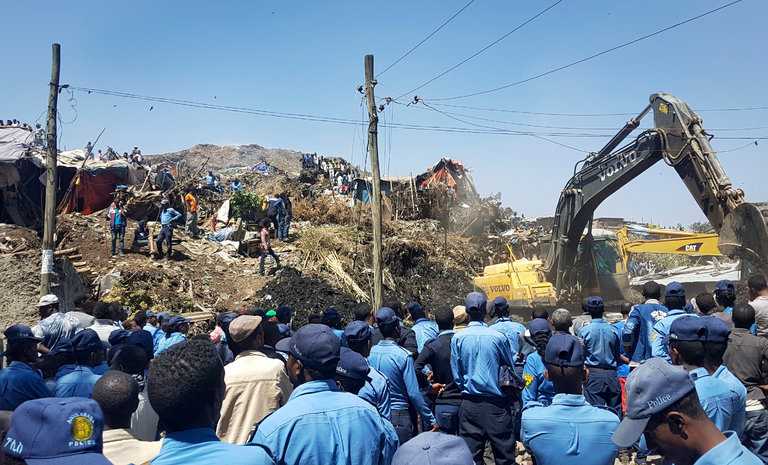
ADDIS ABABA, Ethiopia — A landslide swept through an enormous garbage dump here on the outskirts of Ethiopia’s capital late on Saturday, killing at least 35 people and leaving several dozen missing, residents said, as officials vowed to relocate those who called the landfill home.
Most of the dead were women and children, and more bodies were expected to be found in the coming hours on Sunday, said Dagmawit Moges, a spokeswoman for the Addis Ababa city government.
It was not immediately clear what caused the landslide at the Koshe Garbage Landfill, which buried several makeshift homes and concrete buildings. The landfill has been a dumping ground for the capital’s garbage for more than 50 years.
About 150 people were there when the landslide occurred, said Assefa Teklemahimanot, a resident. Mayor Diriba Kuma said 37 people had been rescued and were receiving medical treatment. Two had serious injuries.
Many people at the landfill had been scavenging items to make a living, but others live at the site because renting homes there, which are largely built of mud and sticks, is relatively inexpensive.
At the site, older women cried, and others stood anxiously waiting for news of loved ones. Six excavators dug through the ruins.
“My house was right inside there,” said a shaken Tebeju Asres, pointing to where one of the excavators was digging in deep, black mud. “My mother and three of my sisters were there when the landslide happened. Now I don’t know the fate of all of them.”
Thank you for subscribing.
An error has occurred. Please try again later.
You are already subscribed to this email.
View all New York Times newsletters.
The landslide may have been caused by the resumption of garbage dumping at the site in recent months. The dumping had stopped in recent years, but resumed after farmers in a nearby region where a new garbage landfill complex was being built objected to dumping in their area.
“In the long run,” Mr. Kuma said, “we will conduct a resettling program to relocate people who live in and around the landfill.”
Around 500 waste-pickers are believed to work at the landfill every day, sorting through the debris from the capital’s estimated four million residents. City officials say that close to 300,000 tons of waste are collected each year from the capital, most of it dumped at the landfill.
Since 2010, city officials have warned that the landfill is running out of room and is being hemmed in by nearby housing and schools.
City officials have been trying in recent years to turn the garbage into a source of clean energy with a $120 million investment. The Koshe waste-to-energy center, which has been under construction since 2013, is expected to generate 50 megawatts of electricity when completed.
Ethiopia, which has one of Africa’s fastest-growing economies, is under a state of emergency imposed in October after several months of sometimes deadly protests by demonstrators demanding wider political freedoms.
ADDIS ABABA, Ethiopia — A landslide swept through an enormous garbage dump here on the outskirts of Ethiopia’s capital late on Saturday, killing at least 35 people and leaving several dozen missing, residents said, as officials vowed to relocate those who called the landfill home.
Most of the dead were women and children, and more bodies were expected to be found in the coming hours on Sunday, said Dagmawit Moges, a spokeswoman for the Addis Ababa city government.
It was not immediately clear what caused the landslide at the Koshe Garbage Landfill, which buried several makeshift homes and concrete buildings. The landfill has been a dumping ground for the capital’s garbage for more than 50 years.
About 150 people were there when the landslide occurred, said Assefa Teklemahimanot, a resident. Mayor Diriba Kuma said 37 people had been rescued and were receiving medical treatment. Two had serious injuries.
Many people at the landfill had been scavenging items to make a living, but others live at the site because renting homes there, which are largely built of mud and sticks, is relatively inexpensive.
At the site, older women cried, and others stood anxiously waiting for news of loved ones. Six excavators dug through the ruins.
“My house was right inside there,” said a shaken Tebeju Asres, pointing to where one of the excavators was digging in deep, black mud. “My mother and three of my sisters were there when the landslide happened. Now I don’t know the fate of all of them.”
Thank you for subscribing.
An error has occurred. Please try again later.
You are already subscribed to this email.
View all New York Times newsletters.
The landslide may have been caused by the resumption of garbage dumping at the site in recent months. The dumping had stopped in recent years, but resumed after farmers in a nearby region where a new garbage landfill complex was being built objected to dumping in their area.
“In the long run,” Mr. Kuma said, “we will conduct a resettling program to relocate people who live in and around the landfill.”
Around 500 waste-pickers are believed to work at the landfill every day, sorting through the debris from the capital’s estimated four million residents. City officials say that close to 300,000 tons of waste are collected each year from the capital, most of it dumped at the landfill.
Since 2010, city officials have warned that the landfill is running out of room and is being hemmed in by nearby housing and schools.
City officials have been trying in recent years to turn the garbage into a source of clean energy with a $120 million investment. The Koshe waste-to-energy center, which has been under construction since 2013, is expected to generate 50 megawatts of electricity when completed.
Ethiopia, which has one of Africa’s fastest-growing economies, is under a state of emergency imposed in October after several months of sometimes deadly protests by demonstrators demanding wider political freedoms.
We’re interested in your feedback on this page. Tell us what you think.



























